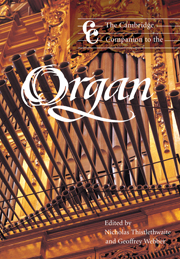Book contents
- Frontmatter
- Part I The instrument
- Part II The player
- Part III Selected repertoires
- 10 Italian organ music to Frescobaldi
- 11 Iberian organ music before 1700
- 12 The French classical organ school
- 13 English organ music to c1700
- 14 Catholic Germany and Austria 1648–c1800
- 15 The north German organ school
- 16 The organ music of J. S. Bach
- 17 German organ music after 1800
- 18 French and Belgian organ music after 1800
- 19 British organ music after 1800
- 20 North American organ music after 1800
- Appendix: The modes (toni) and their attributes according to Zarlino
- Notes
- Bibliography
- Index
14 - Catholic Germany and Austria 1648–c1800
from Part III - Selected repertoires
Published online by Cambridge University Press: 28 September 2011
- Frontmatter
- Part I The instrument
- Part II The player
- Part III Selected repertoires
- 10 Italian organ music to Frescobaldi
- 11 Iberian organ music before 1700
- 12 The French classical organ school
- 13 English organ music to c1700
- 14 Catholic Germany and Austria 1648–c1800
- 15 The north German organ school
- 16 The organ music of J. S. Bach
- 17 German organ music after 1800
- 18 French and Belgian organ music after 1800
- 19 British organ music after 1800
- 20 North American organ music after 1800
- Appendix: The modes (toni) and their attributes according to Zarlino
- Notes
- Bibliography
- Index
Summary
In 1648 the devastating Thirty Years War was ended by the Peace of Westphalia. Though this left some Catholic areas in essentially Lutheran north and central Germany (and southern Protestant areas too, like Nuremberg and Württemberg, including Stuttgart) it was in the south that the Catholic heartlands lay. From Baden in the south-west, they ran through parts of Swabia (including the publishing centre of Augsburg) and Bavaria (Munich pre-eminent) with the large bishoprics of Passau and Salzburg leading to the expanses of the Austrian Empire in which Vienna and Prague were the major centres. These areas had always looked south of the Alps for trade and culture. After the War, with the revival of Catholic Counter-Reformation confidence, Italian baroque art-forms were eagerly adopted, while the desire of many German princelings for monarchical splendour, in the style of Louis XIV, made their courts increasingly receptive to French taste also. The raising of the Turkish siege of Vienna in 1683 and ensuing victories reinforced both the prestige of the imperial Viennese court and the mood of religious triumph in Austria and her supporting German principalities. This was reflected in the many powerful monasteries, such as Melk, Weingarten and Ottobeuren, rebuilt in the first half of the eighteenth century in a dazzling conjunction of princely and celestial glory – artistically, the climax of a process of original re-interpretation of forms invented in Italy and France (the organ at Melk is shown in Figure 14.1).
- Type
- Chapter
- Information
- The Cambridge Companion to the Organ , pp. 204 - 218Publisher: Cambridge University PressPrint publication year: 1999



